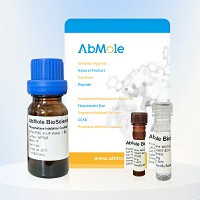All AbMole products are for research use only, cannot be used for human consumption.

Kisspeptin-10, human TFA is a potent vasoconstrictor and inhibitor of angiogenesis, it acts as a tumor metastasis suppressor via its receptor GPR54. Kisspeptin-10/GPR54 signaling induces osteoblast differentiation via NFATc4-mediated BMP2 expression. Kisspeptin-10 (KP-10) and its receptor GPR54 are key components in the regulation of GnRH secretion in humans and other mammals. Kisspeptin-10 protein binds to GPR54. Activation of Kisspeptin-10 suppresses pulmonary human melanoma and Kisspeptin-10 is a metastasis suppressor in breast cancer cells.
In vivo, intravenous infusion of kisspeptin-10 (7.5, 35, and 100 nM) induces a dose-dependent increase in LH secretion. The stimulatory effect of kisspeptin-10 (100 n nM) on LH secretion is blocked by the GnRH antagonist cetrorelix, precluding a singular action on gonadotropes. Kisspeptin-10 inhibits angiogenesis in vivo. Kp-10 inhibits tumor growth in SCID mice xenografted with human prostate cancer cells (PC-3) through inhibiting tumor angiogenesis.
| Molecular Weight | 1416.46 |
| Formula | C63H83N17O14.C2HF3O2 |
| CAS Number | 374675-21-5 (free base) |
| Solubility (25°C) | DMSO 80 mg/mL |
| Storage |
Powder -20°C 3 years ; 4°C 2 years In solvent -80°C 6 months ; -20°C 1 month |
| Related Peptides Products |
|---|
| TMTP1 Peptide
TMTP1 is a 5-amino acid peptide NVVRQ, it can be used for the labeling of malignant in situ and metastatic lesions, and even micro-metastases. TMTP1 specifically bound to the cells of a series of hematological malignancies, including HL60, k562, Jurkat, Raji, El-4 and chronic myeloid leukemia primary cells but not to bone marrow mononuclear cells from healthy subjects. TMTP1, as a novel tumor-homing peptide, can serve as a marker for primary malignant and metastatic lesions. |
| Amylin amide, human TFA
Amylin amide, human TFA is a 37-amino acid polypeptide, it is a pancreatic hormone cosecreted with insulin that exerts unique roles in metabolism and glucose homeostasis. Amylin amide, human TFA inhibits glucagon secretion, delays gastric emptying. |
| WL47 TFA
WL47 TFA, a high-affinity cavolin-1 (CAV1) ligand (Kd=23 nM), is a potent disrupter of CAV1 oligomers. WL47 TFA shows selectivity for CAV1 over BSA, casein and HEWL. WL47 TFA can be used for the study of caveolin-1 function. |
| Angiopep-2-Cys TFA
Angiopep-2-cys is a conjugate of Angiopep-2 hydrochloride and cysteine. The conjugation of anticancer agents with the Angiopep-2 peptide vector could increase their efficacy in the treatment of brain cancer. |
| H3K4(Me2) (1-20)
H3K4(Me2) (1-20) is a histone peptide. H3K4me2 regulates the recovery of protein biosynthesis and homeostasis following DNA damage. |
All AbMole products are for research use only, cannot be used for human consumption or veterinary use. We do not provide products or services to individuals. Please comply with the intended use and do not use AbMole products for any other purpose.


Products are for research use only. Not for human use. We do not sell to patients.
© Copyright 2010-2024 AbMole BioScience. All Rights Reserved.
